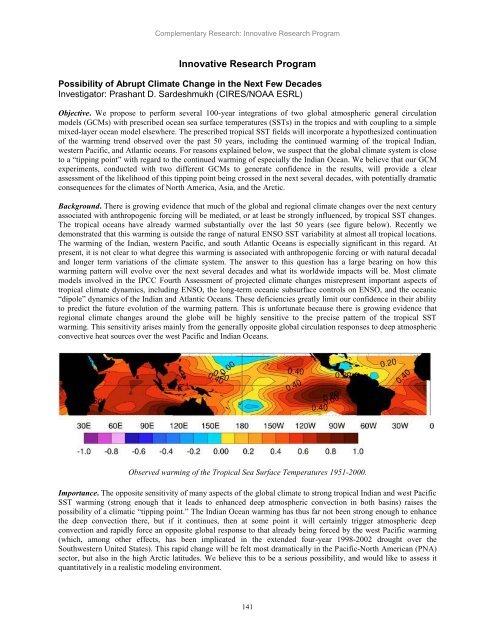Scientific Theme: Advanced Modeling and Observing Systems
Scientific Theme: Advanced Modeling and Observing Systems
Scientific Theme: Advanced Modeling and Observing Systems
You also want an ePaper? Increase the reach of your titles
YUMPU automatically turns print PDFs into web optimized ePapers that Google loves.
Complementary Research: Innovative Research Program<br />
Innovative Research Program<br />
Possibility of Abrupt Climate Change in the Next Few Decades<br />
Investigator: Prashant D. Sardeshmukh (CIRES/NOAA ESRL)<br />
Objective. We propose to perform several 100-year integrations of two global atmospheric general circulation<br />
models (GCMs) with prescribed ocean sea surface temperatures (SSTs) in the tropics <strong>and</strong> with coupling to a simple<br />
mixed-layer ocean model elsewhere. The prescribed tropical SST fields will incorporate a hypothesized continuation<br />
of the warming trend observed over the past 50 years, including the continued warming of the tropical Indian,<br />
western Pacific, <strong>and</strong> Atlantic oceans. For reasons explained below, we suspect that the global climate system is close<br />
to a ―tipping point‖ with regard to the continued warming of especially the Indian Ocean. We believe that our GCM<br />
experiments, conducted with two different GCMs to generate confidence in the results, will provide a clear<br />
assessment of the likelihood of this tipping point being crossed in the next several decades, with potentially dramatic<br />
consequences for the climates of North America, Asia, <strong>and</strong> the Arctic.<br />
Background. There is growing evidence that much of the global <strong>and</strong> regional climate changes over the next century<br />
associated with anthropogenic forcing will be mediated, or at least be strongly influenced, by tropical SST changes.<br />
The tropical oceans have already warmed substantially over the last 50 years (see figure below). Recently we<br />
demonstrated that this warming is outside the range of natural ENSO SST variability at almost all tropical locations.<br />
The warming of the Indian, western Pacific, <strong>and</strong> south Atlantic Oceans is especially significant in this regard. At<br />
present, it is not clear to what degree this warming is associated with anthropogenic forcing or with natural decadal<br />
<strong>and</strong> longer term variations of the climate system. The answer to this question has a large bearing on how this<br />
warming pattern will evolve over the next several decades <strong>and</strong> what its worldwide impacts will be. Most climate<br />
models involved in the IPCC Fourth Assessment of projected climate changes misrepresent important aspects of<br />
tropical climate dynamics, including ENSO, the long-term oceanic subsurface controls on ENSO, <strong>and</strong> the oceanic<br />
―dipole‖ dynamics of the Indian <strong>and</strong> Atlantic Oceans. These deficiencies greatly limit our confidence in their ability<br />
to predict the future evolution of the warming pattern. This is unfortunate because there is growing evidence that<br />
regional climate changes around the globe will be highly sensitive to the precise pattern of the tropical SST<br />
warming. This sensitivity arises mainly from the generally opposite global circulation responses to deep atmospheric<br />
convective heat sources over the west Pacific <strong>and</strong> Indian Oceans.<br />
Observed warming of the Tropical Sea Surface Temperatures 1951-2000.<br />
Importance. The opposite sensitivity of many aspects of the global climate to strong tropical Indian <strong>and</strong> west Pacific<br />
SST warming (strong enough that it leads to enhanced deep atmospheric convection in both basins) raises the<br />
possibility of a climatic ―tipping point.‖ The Indian Ocean warming has thus far not been strong enough to enhance<br />
the deep convection there, but if it continues, then at some point it will certainly trigger atmospheric deep<br />
convection <strong>and</strong> rapidly force an opposite global response to that already being forced by the west Pacific warming<br />
(which, among other effects, has been implicated in the extended four-year 1998-2002 drought over the<br />
Southwestern United States). This rapid change will be felt most dramatically in the Pacific-North American (PNA)<br />
sector, but also in the high Arctic latitudes. We believe this to be a serious possibility, <strong>and</strong> would like to assess it<br />
quantitatively in a realistic modeling environment.<br />
141
















